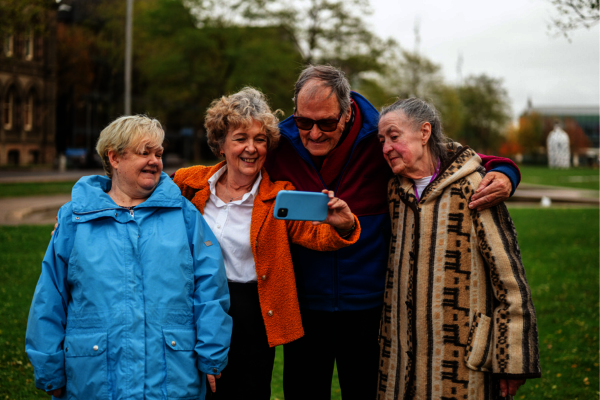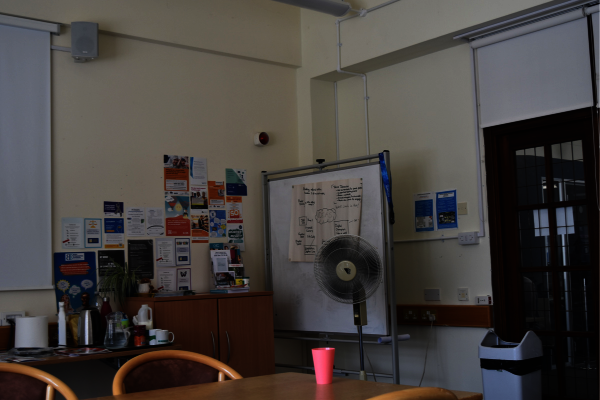Age-friendly case study: Supporting older people to shape their environment through walk audits

Walking audits are a tool many Age-friendly Communities are using in different ways to strengthen the voices of older people in the design of outdoor spaces.
This case study looks at how Age-friendly Bolton are applying the approach as part of local redevelopments.
The need
The design of outdoor spaces has a major impact on our mobility, independence and quality of life as we age – and often, not for the better. Benches removed during the pandemic have not always been replaced; toilets may be unavailable; crossing times at lights too short; and other hazards or obstacles may deter pedestrians in particular wheelchair users or people on mobility scooters. Yet those affected are often unable to have their voice heard.
The redevelopment of Farnworth Town Centre in Bolton is a case in point. Developers had initially conducted a consultation about proposed changes digitally – but Ageing Well colleagues in Bolton council’s public health team understood that this could exclude many older people who were unable to access or use the technology necessary to have their say. The team therefore engaged with both the developers and their own planning department to ensure older people’s needs were being considered, as part of changes to their local built environment.
The solution
The suggestion from the Ageing Well team was to seek feedback from people who were regular visitors to the shopping centre and local area, by conducting an audit walk. This is an assessment of the walkability of an area, building or space, to inform developments or retrospective changes.
In the Farnworth case, the team recruited residents living in sheltered accommodation run by its partner, Bolton At Home, which was very close to the planned development site. The group consisted of people aged 72 to 90, with differing mobility capabilities.
Engagement
Led by a member of the community engagement function within the public health team at Bolton council, the group followed their usual routes to the shops, and together with the Public health team noted the barriers and struggles they faced along the way. These included uneven surfaces, lack of crossings, location of cycle lanes and availability and design of benches. The observations were reported to developers and the planning team.
So useful did the developers find the audit walk that when they embarked on their second wave of developments, they approached the public health team. Not only did they request a similar exercise, but they also presented their plans to a group of older people, to seek their feedback.
The benefits for people
Older people who had participated in the walking audit felt their opinions were valued, and that they were able to impact meaningful change in their place.
Val Simm, one of the walk participants, said: “I felt it was really useful to see the changes being made and potential developments and improvements on the way. I was pleased to take part in the walk and hope the council listens to our suggestions.”
For partners
Both the developers and Bolton’s Highways and Planning Directorate found the audit walk process had provided valuable insight from members of the local community.
Since the walk, the planning department and developers have continued to approach the Age Well Partnership for audit walks, to better understand what older people in Bolton need and want to be able to enjoy what their place has to offer.

For place
While the works in Farnworth were ongoing at the time of writing, a recent audit walk in Bolton town centre had resulted in changes to the positioning of dropped kerbs, improvement to paving that had not previously been noted as a route for older people to access the market, and increase in pedestrian crossing timings.
In the longer term, this heightened awareness among Planners and developers of the valuable contributions older people can make through direct engagement, is likely to improve the way that spaces are designed, with the needs of an ageing population taken better into account.
The learning
In the Farnworth case, time was short to recruit members for an audit walk, but the public health team recommends that a variety of methods are used to assemble a representative group of users when time permits. These might include using community facilitators, working with local Voluntary and Community Sector organisations like Age UK, and local advertising.
Other tips are:
Plan early
- Start working with developers early on in the planning process for any new scheme
- Find passionate people in relevant departments to work with
- Work with Planners to ensure developers incorporate changes they commit to or are funded for
- Make the most of existing toolkits to shape what you might ask on the day
Manage walks carefully
- Recruit people with various experiences of the built environment
- Make the most of opportunities for audit walks – don’t let perfection get in the way of progress
- Keep it informal – don’t rush the walk or feel too tied to toolkits – adapt on the day as you need
Communicate clearly
- Use the walk as an opportunity to bring the community together
- Communicate clearly – you don't want to unjustifiably raise expectations of changes that are unlikely to happen
- Feedback to participants to ensure they feel listened to
Don’t see cost as an issue
- Little or no budget is involved!
Further resources
In other communities, walking audits are being used in a variety of ways, such as to improve the experience of parks and green spaces, Of public transport, and routes between residential care homes and town centres.



